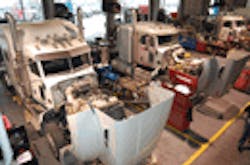A soon-to-be released study by global research firm Frost & Sullivan predicts major change for the U.S. engine oil market for Class 4-8 trucks by 2018, driven heavily by the need to boost fuel efficiency ahead of new federal greenhouse gas (GHG) mandates for commercial trucks along with increased use of smaller engine blocks and hybrid propulsion systems.
The firm also believes that the vertical integration trends among global truck manufacturers may lead to more intricate partnerships with lubricant makers, fostering the creation of “private label” engine oils, transmission fluids, etc., which could ultimately result in tighter OEM engine oil specifications to maintain warranty coverage.
In an interview with Fleet Owner, Sandeep Kar and Wallace Lau – respectively the global director of commercial vehicle research and truck research analyst for Frost & Sullivan – explained engine oils change to much lower viscosity formulations over the next six years to boost engine efficiency and thus fuel economy.
Research by both Kar and Lau indicate that 5W-40 and 5W-30 – even so-called “zero weight” oil blends of 0W-20 and 0W-30 – are being developed for medium- and heavy-duty truck engines in an attempt to generate the fuel savings necessary to meet federal fuel economy rules. However, Lau stressed that the challenge for such “low” and “no weight” oils will be maintaining engine protection properties as well as temperature handling characteristics.
“Right now, one of the issues with low viscosity oils is that they do not apply well in warmer regionsof North America,” Lau pointed out. “Yet [diesel] fuel costs across all of the U.S. and Canada are predicted to only keep rising, so fleets want the fuel saving advantage of a low viscosity fluid. Our fleet focused research indicates steadily rising interest in advanced engine oils which is already translating to rising aftermarket demand for synthetics and semi-synthetics. It is only a matter of time before we see these fluids in the factory-fill market.”
The challenge for engine oil providers, however, is that overall market demand for engine oil isn’t projected to increase much at all over the next six years, noted Lau – primarily as the increasing use of 13L engines and hybrid powertrains is decreasing the amount of engine oil used in the Class 8 truck market; the largest consumer of truck engine oil.
Overall engine oil consumption is only expected to grow by 1.9% through 2017, according to Frost & Sullivan’s research – rising from a projected 3.26 million gallons in 2012 to 3.72 million gallons five years from now.
That means there will be more pressure placed on engine oil suppliers to improve the chemistry of their products so as to add value to truck owners, along with the need for greater customer service and support efforts in the field, Kar and Lau said.
Interestingly, however, the firm found in its study that OEMs will almost exclusively continue to “factory fill” truck engines with cheaper mineral-based oil instead of synthetic blends – which, by contrast, are being purchased in greater quantities among trucking fleets.
“We were frankly baffled by this [factory fill] trend as there is a lot of demand in the aftermarket for synthetics,” Kar noted, pointing out that advanced synthetic low viscosity oils can help boost fuel economy by 1 to 2%.
He noted, though, that the OEMs are most likely still choosing to “factory fill” with mineral-based oil because it remains far cheaper. Lau added that Frost & Sullivan’s research indicates that mineral-based engine oils in the U.S. cost an average of $7.80 per gallon in 2011, versus $21 per gallon for synthetic blends – and as the average Class 8 truck requires 10.5 to 11 gallons worth of engine oil, that cost differential can add up very quickly to a fleet’s bottom line.
Yet Kar contends that demand for synthetics will continue to grow, even though by 2017 they are expected to cost an average of $24 per gallon versus $10 per gallon for mineral-based oils, because synthetic blends offer the promise of better fuel economy, longer drain intervals and more advanced engine protection properties.
“In our survey of Class 4-8 fleet managers, we found that 26% considered advanced engine oils a very important technology, with 52% rating it somewhat important – far higher than APUs (auxiliary power units), natural gas propulsion systems, hybrids, etc.,” Kar stressed. “Right now, we’re in a price-sensitive [trucking] environment but we believe as the cost of fuel rises and the need to help lower operating costs increases, synthetics will gain more favor.”
About the Author
Sean Kilcarr
Editor in Chief
Sean Kilcarr is a former longtime FleetOwner senior editor who wrote for the publication from 2000 to 2018. He served as editor-in-chief from 2017 to 2018.
